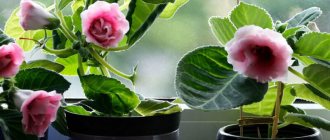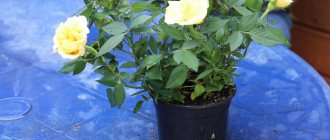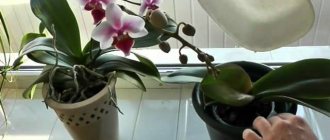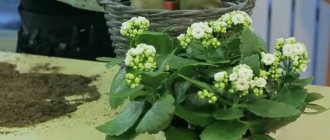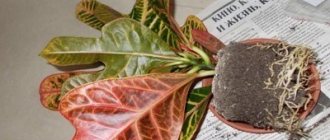- February 6, 2019
- Flowers
- Svetlana Pavlova
Cyclamen (or cyclomenia) is an incredibly beautiful plant. Its magnificent flowers resemble tongues of frozen flame. In any flower shop you can buy a brightly blooming plant all year round. Its unusual appearance attracts both beginners and experienced gardeners. However, in order to avoid difficulties associated with care, you need to familiarize yourself with some nuances. Particular attention should be paid to proper care and replanting after purchasing a cyclomenia flower, otherwise it may die after some time.
Description and types
The popular name of the flower is drakva or alpine violet. Cyclamen is a perennial herbaceous plant that belongs to the Primrose family. Flower shoots (tubers) are round in shape up to 15 cm in diameter. The height of the flower is from 10 to 25 cm and depends on the variety. This plant has no stems. The green leaves with a silvery pattern are heart-shaped. Charming flowers of various shades are located on high peduncles and delight the eye all winter and until spring. There are more than 60 different plant species. For home cultivation, two types of cyclamens are most often used:
- Persian - the plant grows up to 30 cm, the diameter of the tuber is about 15 cm, heart-shaped green leaves with a gray pattern. The flowers are on long stalks and have an elongated shape. It blooms in winter, and in summer the cyclomenia flower shown in the photo does not require care, except for minor watering. During this period it is at rest.
- European - slightly inferior in size to Persian, has a tuber with a diameter of about 10 cm. The leaves on the reverse side are dark red and do not fall off after the end of flowering, which occurs in the summer, and in winter the flower rests.
Types of cyclamen for the home
- Persian - depending on the variety, it can grow within 15-30 cm. It has large velvety leaves that are pubescent and core-shaped. The flower consists of five petals, the color may vary.
- European - looks very similar to the Persian type of cyclamen, but the leaves are dark green and purple underneath. The European species is much smaller in size than the Persian, the height of the flowers is only 2 cm. This type of plant requires minimal care.
Rules for choosing a flower
Before purchasing, you should carefully inspect the plant to make sure there are no damaged or limp leaves. The bush itself must have:
- strong stems;
- be thick and dense;
- the top of the tuber should stick out of the ground.
If the plant blooms, it is better to choose it with a large number of buds. The best time to buy is autumn. If you purchase tubers, they must be healthy. First of all, pay attention to the growth bud. When purchasing, you should give preference to dense and weighty tubers.
Soil selection
How to replant flowers? The success of this process largely depends on the correct choice of soil. For each plant, a special soil is selected specifically for it. Purchase the required composition at the flower shop. When purchasing, slowly read the instructions on the package
Pay special attention to the composition and acidity of the soil
If you do not have the necessary substrate, purchase a mixture that is used for indoor plants from the same family. Do not use soil from your garden plot for replanting; its composition is most likely not suitable for your flower. In addition, it may contain pathogens and pests. Before using the soil, it is best to sterilize it in the oven at 100 degrees. This will be a good preventive measure to destroy viruses and germs.
Procedures after purchase
After acquiring cyclomenia:
- You need to carefully examine the plant again. If damaged leaves and flowers are identified, remove them.
- The plant is kept in quarantine for some time and treated for preventive purposes.
- All plants purchased in the store require careful care and replanting.
After purchasing a cyclomenia flower, you need to inspect the root system. Replace the substrate, since the transport soil in which the plant arrives at the store is filled with a large amount of fertilizer to maintain it in marketable condition. Often the substrate contains larvae of various pests. When replanting a plant into new soil, you should carefully remove the old one and wash the roots. Often the transplanted plant withers and dies. This occurs after intensive feeding of cyclamen with stimulants, and the plant becomes dependent on them. Therefore, experts give the following advice on care after purchasing and replanting a cyclomenia flower:
- fertilize more often, gradually reducing the dose of fertilizer;
- if rotten areas on a tuber are identified, they must be removed and the cut areas sprinkled with activated carbon;
- The entire tuber should not be buried in the ground; the upper part should stick out of the pot;
- pre-steam or calcinate the purchased soil.
Rules for replanting cyclamen
Replanting cyclamen is one of the most important aspects of growing, because if replanted incorrectly, the plant may not take root or may not develop properly. Cyclamen needs to be replanted once every 2 years.
As a rule, the best time to repot a plant is in preparation for the dormant period. It is also worth choosing the right flower pot; it should not be high and not too wide, then the plant will develop well.
The soil should consist of a mixture of humus, sand, peat and leafy parts. A small layer of drainage should be placed at the bottom of the flower pot, and then soil. The seedling should be planted with a tuber of old soil in the center of the pot and sprinkled with soil. After transplantation, the plant needs to be fed only after a month.
Lighting and temperature conditions
Illumination for cyclamen plays an important role. The flower prefers diffused light, so it is placed on western or eastern windows. Direct sunlight has a detrimental effect on the plant. For the cyclomenia flower shown in the photo, care at home necessarily requires compliance with the temperature regime.
During the flowering period, the optimal temperature is 10–12 degrees. At higher rates, the plant may stop flowering. To create a lower temperature, place the flower on a cold window and regularly ventilate the room. However, it is necessary to ensure that there are no drafts.
What conditions need to be created at home?
Persian cyclamen is an ephemeroid, which means its life cycle is clearly divided into periods of active growth and dormancy. It is often used to decorate the home for one season only, but if certain conditions are met, the plant can be preserved and caused to bloom again.
Placement and lighting
The flower needs a bright, diffused color and the optimal place for it would be an eastern window. From lack of sun, leaves can turn yellow, and direct rays can cause burns.
The plant is demanding of clean air and does not tolerate gas pollution and tobacco smoke. Both cold drafts and hot air flow from heating appliances should be avoided.
Do not keep plants in close quarters; lack of fresh air can lead to rotting. After flowering, the plant goes dormant, and the pot should be moved to a shady place until the end of summer. Some gardeners recommend placing the pot with the tuber on its side.
At home you can grow such ornamental flowering plants as:
Temperature
One of the most important conditions for cyclamen flowering is cool temperature. During the day, the thermometer should record from +12°C to +15°C, and at night it can be lowered to +10°C.
If the air warms up to +20°C, the flower may go into hibernation mode. In such heat, spider mites are also active, which can cause the death of the flower. During the dormant period, the plant is kept at a temperature of +18…+22°C.
Air humidity
The plant loves high humidity, and its leaves are regularly sprayed. The flower pot can be placed on a tray with moistened expanded clay. When the buds appear, the foliage is stopped moisturizing. Drops falling on the petals can cause rotting.
Watering and fertilizers for cyclamen
The flower must be watered regularly with settled water, but stagnation of moisture is detrimental to it. It is best to water in a tray or immerse the container with the plant in water, then it will take the required amount of moisture. Providing moist air is one of the conditions for proper care at home. The cyclomenia flower, the photo of which is posted in the article, does not tolerate dryness and does not like droplets of water falling on the leaves and flowers. Therefore, the air is humidified with a spray bottle or water is poured into a container with pebbles and placed near it. During the flowering period, cyclamen needs to be fed every two weeks. To do this, use liquid fertilizers for flowers, after watering the flower.
Care
Watering
During flowering, cyclamen is watered abundantly, avoiding waterlogging. During the dormant period, watering is reduced, but the soil should not dry out. Water for irrigation is used at room temperature.
Do not flood the tuber and the base of the petioles. Cyclamen also does not like water getting on its leaves. It is carefully watered into the edge of the pot, or preferably from below through the tray. You can use the immersion method. The pots are lowered into containers with water to the soil level and left until the water reaches the soil surface through the drainage holes. Then the pots are lifted, placed so that excess moisture drains off and then transferred to a permanent place.
Top dressing
Feed cyclamen during initial growth and flowering once every 2-3 weeks with liquid fertilizer for flowering plants. During the period of leaf growth, plants can be watered 1-2 times with a weak solution of organic fertilizers, for example, well-fermented mullein. It is diluted with water in a concentration of 1:30. But you shouldn’t get carried away with nitrogen fertilizers. Overfed plants have little resistance to diseases and pests and bloom poorly. During budding and flowering, cyclamen should receive enough potassium and phosphorus. During the dormant period, plants are not fed.
Transfer
Transplantation is performed infrequently; it is done in the following cases:
- after purchasing a ready-made plant in a store;
- if the soil is infected with pests, pathogens, and replacing the top layer does not produce results;
- when replacing an old cramped pot with a new one.
In the latter case, cyclamen are replanted in August-early autumn, after a dormant period. The containers selected are not too large, taking into account the age of the plant. The optimal distance from the walls to the tuber is 3-4 cm. For a two to three year old plant, a pot with a diameter of 15 cm is suitable.
Having prepared the containers, drainage and soil, begin replanting. The cyclamen is carefully removed from the pot and the soil is shaken off from the roots. If there are rotten roots, they are removed. Expanded clay is placed at the bottom of the pot, the substrate is poured and the plant is placed in it. For Persian cyclamens, it is important not to completely bury the tuber when replanting. It should protrude 1/3 out of the ground. The European cyclamen tuber is completely buried.
Features of care during the rest period
In winter and early spring, cyclamen has the most intense period of development and growth. After flowering, preparation for the dormant period begins. Cyclamen does not form new leaves; old ones begin to turn yellow and wither. Leaves can be removed only after they are completely dry. Care at this time is minimal; no feeding or moisturizing is needed. Water little and rarely - once every 2 weeks, so that the tuber does not dry out at all. The pots are transferred to a dark place. The air temperature required for plants at this time is 15-17°C.
The dormant state lasts from mid-spring to early autumn . The fact that cyclamen is beginning to wake up can be seen by the appearance of new leaves on the tuber. The plant is brought out into the light, watered more often, replanted if necessary, and normal care is resumed.
Some questions about care
Why does cyclamen wither and turn yellow?
Dry and warm air in the apartment negatively affects the condition of cyclamen, especially in winter when heating appliances are running. Yellow spots appear on the leaves, but the flowers may look strong and healthy.
Yellowing can begin due to a lack or, conversely, excess moisture.
The appearance of pests weakens the plant, the above-ground parts look lifeless, wither and dry out.
Yellowing and wilting of leaves also develops due to prolonged exposure of cyclamen to bright and direct sunlight.
Another reason is the natural death of shoots and leaves after flowering. This is how the plant begins to prepare for rest.
Why doesn't cyclamen bloom?
For Persian cyclamens, one of the reasons for the lack of flowers is improper planting of the tuber. A third or half of the plant tuber should be on the surface of the soil.
Lack of nutrients or frequent use of nitrogen fertilizer also has a bad effect on flowering.
Another possible reason is that planting cyclamen in large pots may slow down the onset of flowering.
Features of caring for cyclamen after flowering
Abundant flowering of cyclamen throughout the winter period depletes it, and by spring the plant needs a long rest. The leaves turn yellow and gradually die, and the tuber becomes bare. Care for the cyclomenia flower after flowering is as follows:
- reduce watering;
- put the flower in a cool and dark place.
The soil in the pot should not dry out; periodically it is necessary to lightly water the plant. Until the end of the summer period, cyclomenia remains in this state. In autumn, in September, the plant enters a new stage, therefore:
- the pot is taken out and put in its original place;
- resume normal watering;
- if necessary, the tuber is replanted, removing damaged roots;
- the plant is fed.
During the dormant period, flower care is very simple, but these rules must be strictly followed. Its further flowering will depend on this.
Cyclamen flower - photo and brief botanical information
The debate has still not subsided about which family the herbaceous perennial belongs to - the Myrsinoves or the Primroses. The distribution of the genus of cyclamen in nature is concentrated in the warm climate of Mediterranean countries, Northeast Africa and Turkey. There is also the popular name "dryakva".
The variety of colors of cyclamen in nature:
This plant, which is nicknamed Alpine violet, is also found in the southern part of Europe.
This tuberous plant is small and does not take up much space either in nature or in a pot on the windowsill. The wide leaves are patterned and round in shape, with some fringe. Small or large flowers rise above the leaves in a slender row. The colors of the flowers are very diverse.
If you decide to get cyclamen at home, then you should take into account that it is an ephemeroid: after the growing season and flowering period, you will only be pleased with the bare soil in the pot, while underground in the tuber the next life cycle will take place.
Reproduction of cyclamen
Cyclamen is propagated in two ways - vegetatively and by seeds. Vegetative propagation of the cyclomenia flower and its care are as follows:
- the tuber is freed from soil and dried;
- cut into several parts so that each of them contains roots and a bud with leaves;
- Each cut is sprinkled with crushed coal.
Planting material is planted in pots two days later. After planting, watering is carried out infrequently. It takes a little over a year before cyclamen blooms. The vegetative propagation method is used only during the dormant period.
The best time to propagate cyclomenia by seeds is February or March. The seeds are soaked for 12 hours before planting and then planted in previously prepared soil. Cover the container with film and put it in a dark place, moisten it daily with a spray bottle. Sprouts will appear within a month. The container is moved to a lighted place, avoiding direct sunlight. The flower begins to bloom after about 15 months.
How to care for cyclamen at home?
Taking all the measures to create the best home conditions and proper care for your Persian or European cyclamen will definitely pay off with beautiful, bright flowering. Therefore, pay close attention to the care recommendations below - we tried to cover everything as informatively as possible. It’s better to know all the nuances of growing before purchasing. In the article below you will see a photo of cyclamen, tips for caring for and replanting the flower.
Location and lighting
Many cyclamens feel great on the north side, but in general this arrangement of this beautiful flower is not recommended. There should be a lot of light, but without direct sunlight. Therefore, feel free to place the pot on the eastern or western windowsill. If the windows only face south, you can place the flower in front of the window. Tulle will protect delicate flowers and leaves from the burning rays.
Humidity and temperature conditions
In winter, it is recommended to keep plants at +12°C and sufficient light. In summer, standard room temperature is suitable. Despite the love for high levels of humidity, the room needs regular ventilation and the leaves need to be sprayed. But when flowering begins, spraying is stopped. You can place the pot on a tray with pebbles and pour water into it. The main winter enemy is the heating radiator.
How to water cyclamen at home
Caring for cyclamen at home does not allow mistakes in watering. To avoid mistakes, use only bottom watering: place the pot in water and wait for moisture to appear on the top layer of soil. After this, you can place a plant to drain the water. Water the plant abundantly during the growing season and flowering.
Soil for cyclamen
The roots of this plant are demanding of air access, so the substrate must be coarse-fiber. Good soil is considered to be composed of several components in equal parts, namely sand, humus, peat and 3 parts of leaf soil.
Transplanting cyclamen at home
With proper care, replanting a cyclamen flower should be done every 1.5-2 years and in the case when the corm becomes crowded. The process begins at the moment of rest, before the start of the vegetative period. Flowering is possible only in a very compact container, so you need to maintain a balance: a tuber that is 1.5 years old needs an 8 cm pot, if the corm is 2-3 years old, then the diameter is 15 cm. That is, the tuber should not touch the walls of the container, but up to they should be only 2-3 cm.
First, a layer of drainage is laid out in a new container, then a little new soil, a tuber with roots is laid out on it with part of the old substrate, and then it is supplemented with fresh soil. The immersion of the Persian cyclamen tuber should not exceed ⅔. The substrate must be compacted and watered to ensure stability in the new soil.
You should definitely see the top of the corm
Fertilizer and feeding
The feeding schedule is simple: once every two weeks during the period of leaf appearance and until the end of flowering with any complex mineral fertilizer.
Disease and pest control
This plant, which is very resistant to the disease, is still affected by mites, and it is not easy to identify the pest. If the leaves and flowers begin to deform and bend, this indicates the presence of thrips, aphids or mites. The plant is treated with Aktara or Fitoverm.
If in a European variety the tuber suddenly begins to rot due to excess moisture during watering, then it is better to remove it completely and remove the sore spot. The remaining healthy tuber is dipped in a solution of potassium permanganate, dried and planted in a fresh substrate.
ADVICE!
In case of any disease and transplantation into new soil, it is better to pre-steam the latter in the oven.
Caring for a cyclamen flower after flowering
After a period of bright flowering, the plant prepares for dormancy. This is noticeable by yellowing and falling leaves. Tear off the dry parts of the cyclamen; those that are still holding tightly are better cut off at the root. Watering is reduced to small doses. The substrate is kept slightly moist. The pot moves to another place for a period of rest, where it is cool and there is no bright light.
Propagation of cyclamen and care of young seedlings
Plant propagation occurs in two ways: by seed and by dividing the tuber. Which method is more convenient is up to you to choose, and we will tell you how cyclamen reproduces.
Seed method
The Persian species is propagated by seeds, which are best sown from mid-February to late March. To do this, you should soak the seeds for several hours in a weak solution of potassium permanganate or Epin.
- The soil for the future cyclamen must be steamed and completely suitable for the plant.
- Seeds are sown in a groove no deeper than 1 cm and spilled with water at a distance of 3 cm from each other. Sprinkle a small layer of soil on top and cover the entire container with a transparent film.
- The air temperature for seed germination should be maintained at +18-20°C
The period for sprouts to appear varies from 1 to 4 months. After they appear, the film is removed, and after two true leaves appear on the sprouts, the seedlings are planted 3 pieces into one pot. The tubers are under the soil!
Transplantation into permanent hills with a diameter of 7 cm occurs 6 months after germination.
Tuber division
It is easier for many to propagate cyclamen by dividing the tuber during the dormant period. The tuber is dried and divided into several parts with a clean knife, each with a root and a bud. All cut points should be sprinkled with any type of coal and the future plant should be planted in a new container.
Preparing for transplant
After flowering stops, cyclamen leaves begin to turn yellow, and a period of dormancy begins. At this time it is transplanted. To do this you need to prepare:
- Drainage - use shards, expanded clay, brick chips, pieces of foam plastic, gravel.
- Soil - you can buy it in a store or prepare it yourself using: humus from leaves, garden soil, sand and perlite. Sometimes a little peat or coconut fiber is added. Everything is thoroughly mixed and sterilized.
- Pot - its size is chosen according to the size of the root system. If there are roots sticking out in the drainage holes, then a new pot should be taken a little larger than it was. In a large container, the plant does not develop well and may get sick.
- Activated carbon - used to disinfect areas where roots have been cut. It is crushed before use.
- Spray bottle - for spraying roots.
Why do you need to transplant cyclamen into another pot?
As the above-ground part of the flower grows, the tuber also grows. Experienced gardeners know that cyclamen is grown in a small pot. Based on this, during the annual cycle the plant depletes the soil, and if it is not replanted, it weakens and may die.
Some unknowingly fertilize the flower, which only aggravates the situation. In this case, the flower needs a new pot and soil.
Did you know? The ancient Romans believed that if a pregnant woman wore cyclamen jewelry, childbirth would go smoothly.
Cyclomenia flower. Transplantation and care
Cyclamen under the age of three years are recommended to be replanted annually, and adult plants - once every two to three years. Drainage is placed in the pot, the layer thickness is 3 cm, then the same layer of soil is poured. The cyclamen is freed from the old pot, the soil is shaken off the roots and washed with warm running water. Carefully inspect and remove damaged ones. The cut parts are sprinkled with crushed coal. Excess foliage is removed, the roots are sprayed, straightened and covered with soil, leaving the tuber outside. The photo shows a cyclomenia flower transplant, after which the care is as follows:
- the flower is placed in a cold place;
- do not water for two days;
- watering after transplantation is not abundant for about a month;
- humidify the air around the flower with a spray bottle once a day.
Then all care procedures are carried out as usual.
Why does cyclamen not bloom after transplantation?
Many people encounter this problem when the purchased cyclamen bloomed beautifully, but after replanting it is of no use. Here you need to correctly identify the mistake made and correct it in a timely manner.
After transplanting a flower, you should not place it near an open window.
Lack of flowering can occur in the following cases:
- poor composition of the new soil mixture;
- the tuber was planted at the wrong depth;
- violation of transplantation technology;
- failure to provide an optimal microclimate after transplantation;
- violation of watering or fertilizing rules.
Poor soil disinfection leads to the fact that all pests do not die. They attack the tuber, and the cyclamen refuses to bloom. If the soil mixture is not nutritious, even fertilizing will not save the situation.
It is important to know that flowers that go on sale are treated with chemical flowering stimulants. For this reason, the purchased crop blooms for a long time, which drains a lot of energy from it. After this, it may even take two seasons to recover.
Diseases and pests of cyclamen
Most often, cyclamen gets sick from non-compliance with the rules of care. The following are diseases that are often encountered when growing flowers:
- Fusarium - the disease is caused by a fungus that is found in the soil and affects the root system. The leaves of the flower turn yellow, sometimes on one side, and it stops blooming. The plant is watered with “Fundazol”, and the leaves are sprayed with “Topsin-M”.
- Wet rot is a bacterial disease. The roots rot, as a result the plant dies and must be destroyed.
- Anthracnose - often appears during the flowering period. The reason is high temperature and humidity. Death of leaves and flower stalks occurs. It is necessary to move the cyclamen to a cooler room, reduce watering, and treat it with Fungicide.
- Sooty fungus - a coating appears on the leaves, causing them to dry out and curl. The plaque is washed off with a cloth soaked in soapy water.
If not properly cared for, the cyclomenia flower at home is not only susceptible to disease, but it is also affected by pests:
- Thrips are winged insects that can fly to other plants. They settle on leaves and feed on their juice, laying larvae. In addition to leaves, roots are also affected. They can be detected by the dried edges of the leaves and the presence of white spots on them. To kill pests, the plant is treated with insecticides.
- Cyclamen mite - located on the underside of leaves in the form of a white coating. The buds and flowers wilt, and the leaves curl. Insecticides are used to kill the parasite.
Preparing the plant
When growing cyclamen at home, proper care is necessary for its full flowering. Moreover, the care will be almost the same for all varieties. The Persian variety is most often grown at home. But there are also many other varieties.
All varieties (European, Persian, etc.) require periodic replanting
Please note that cyclamen needs to be replanted once a year and only after the flowering period has ended. A blooming flower cannot be touched in the same way as one that is at the budding stage
In order for the transplant to be successful at home, it is necessary to properly prepare for this procedure. First you need to prepare the soil. The speed of acclimatization of the plant to it depends on how correctly the soil was selected. The soil in which the flower has been located for a year is quickly depleted, especially without additional fertilizing, which can lead to the death of the plant. Therefore, the soil should be selected correctly even at the preparation stage.
During the replanting process, the soil must be completely replaced. Properly prepared soil composition is the key to the success of the entire procedure. For cyclamen (Persian, European, etc. varieties) grown at home, the soil should have the following composition:
- leaf soil;
- humus;
- sand;
- peat.
Before you start replanting, prepared or purchased soil must be calcined for an hour in the oven. In addition to the oven, you can use a regular frying pan. You can also simply treat the soil with a solution of potassium permanganate. This procedure must be done in order to prevent infection of the plant by fungi and other pathogenic microorganisms.
At this stage, it would be correct to prepare another pot. It must be a little larger in size. But the pot should not be very large. Otherwise, water will stagnate in the soil, which will lead to rotting of the tuber. If the selected pot is smaller, then the cyclamen may begin to bloom earlier than expected. In principle, you can use an old pot, but it should be washed and disinfected well.
Please note that the pot must have holes in the bottom to create excellent drainage from pebbles or expanded clay. If this is not done, the soil will become very waterlogged in the future, which will lead to the death of the flower, even if the care is correct
The plant itself does not need to be specially prepared. The only thing that needs to be taken into account is that the transplant is carried out before budding begins in the summer (mid-summer). Although different varieties (Persian, European, plateau, etc.) may have a slightly different period suitable for replanting. The time when it is possible to transfer a flower to a new pot is determined by the stage of sleep and active growth. The signal that the plant can be replanted is the appearance of several new leaves on the tuber after it has completed the dormant stage.
Useful tips
Experienced amateur flower growers recommend:
- European cyclamen, which blooms in summer, should be planted in open ground. It is better to choose a shaded place, without direct sunlight. In autumn, the flower is returned to home conditions.
- During the flowering period, with good care after purchase, cyclamen forms more than 50 buds. Its flowers are cut and created into bouquets. In order for them to remain fresh for up to two weeks, the flower stalks are cut lengthwise into 2-3 parts, and the water is changed after two days.
- Gray rot occurs at low temperatures and high humidity. Frequent ventilation will help get rid of it.
- Yellowed leaves may appear at temperatures above 18 degrees. Lowering the room temperature and moving the flower to another location will help cope with this phenomenon.
Transplanting flowers
Planned replanting of cyclamen at home occurs every 2-3 years. The time depends on the type of plant - European ones are replanted in the spring, and Persian ones in the fall. This is the period before the start of active growing season. The procedure is performed using the transshipment method. The plant is placed in a new pot with a lump of earth entwined with roots. Just add the required amount of soil into a larger container. Don't forget about the drainage layer.
When replanting purchased flowers, it is recommended to thoroughly clean the roots of old soil. An earthen mixture for bulbous plants (“Tulip”, “Florin”) is poured into a new pot. The soil should be slightly acidic. For a young cyclamen, a pot with a diameter of 7-8 cm is enough, for an older one (3-5 years old) - 14-15 cm.
When planting, the tuber of the European cyclamen is completely covered with soil, and the Persian one is only 2/3 covered. In a high-quality substrate, fertilizing will not be required for 1-2 months.


